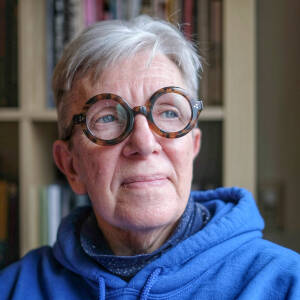Hyung-taek Cho, Again: His Exquisite Work
I’ve been taking a homeopathic cold remedy since yesterday afternoon, and my cold receded enough that I was able (masked) to attend the talk by photographer Hyun-taek Cho this afternoon and then go out to dinner (unmasked) with Sue. I came back to my place after dinner to avoid spreading cold germs in Sue’s house.
I’m quite shaken by Mr Cho’s photographs. They juxtapose light and darkness, life and dereliction. His subject matter is abandonment, and yet his photographs are a record of connection with abandoned spaces. I have loved and studied photographs since I was a child, but I have never seen any like these. So of course I wanted to hear more about his work. He delivered his talk in Korean, and a translator (the woman on the left in the photo) gave us the English version.
Cho’s mother died when he was a small child, and he was reared in poverty by his grandmother in a single room they shared in a village called Naju. He completed a BA in photography and a Master’s degree in history and philosophy, but just as he finished university, his grandmother died, and the little one-room apartment where they had lived was marked for demolition. His artist statement reads in part, “When I returned home from her funeral, a little white butterfly entered our room. It was a moment when the living and the dead overlapped as if one…. What I wanted was to overcome the stern objectivity of photography, the very medium that fossilizes the moment it is taken.”
He began visiting condemned and abandoned homes, using the camera obscura technique to project the living world outside onto the abandoned walls inside the house. As part of his talk he showed a video of his process: first he makes several prostrations before the house with the room he is going to photograph, paying respect to the life that the house held; then he covers doors and windows with black cloth. He punctures holes in the cloth, allowing light to enter from several angles, forming a camera obscura; finally he makes three-to-five-minute digital exposures of the room with the life outside projected onto its walls. He also collects any objects left behind in the house: toys, rusty hammers, a book, a framed photograph. He photographs the objects, and in Korea he also exhibits the abandoned objects as further homage to the life of the house. Sometimes he also goes back after demolition has begun and photographs the rubble. His work brings life back into the abandoned home briefly, so that, as he says, “the living and the dead overlap as one.”

Comments
Sign in or get an account to comment.


